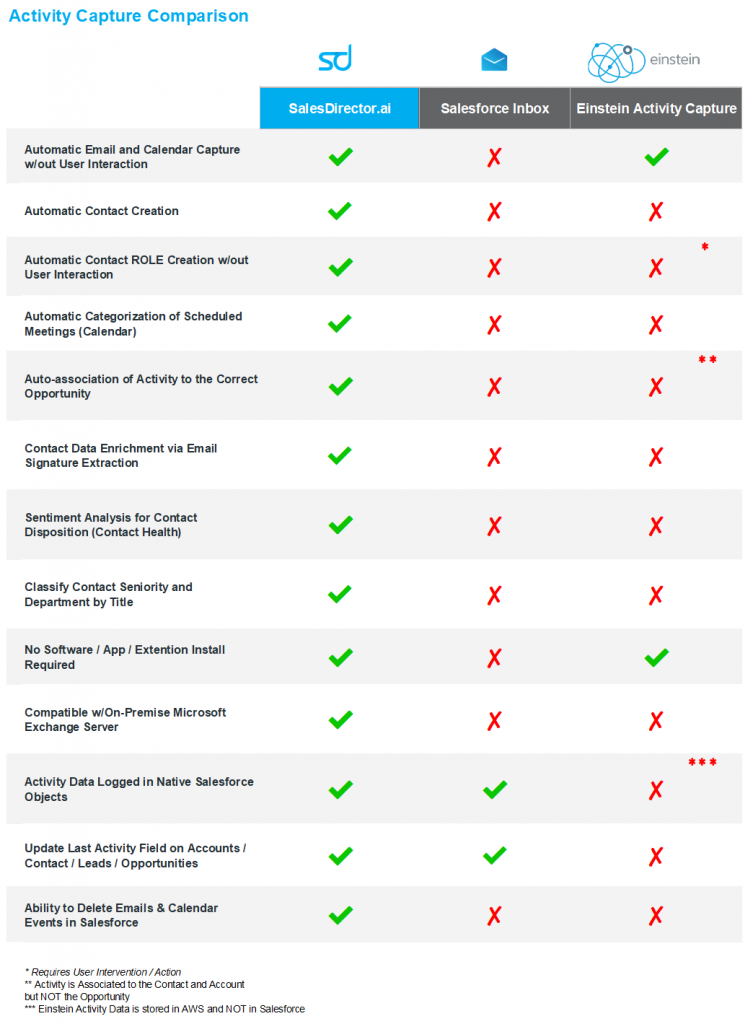Most B2B SaaS companies are using Salesforce as their CRM and system of record. Salesforce has rightfully earned the position of being the biggest SaaS of them all. But what started out as the little guy declaring “No Software” against the “Big Iron” establishment has turned into David becoming Goliath.
Today the Salesforce ecosystem sprawls beyond CRM and snakes into Marketing, Finance, Support, Social, Messaging, Dashboarding, Reporting, Document Management, Project Management, collaboration and now artificial intelligence.
A few years ago Marc Benioff made the declaration that he relied on an Artificial Intelligence machine known as “Einstein” every Monday morning at his executive round table. After his discussion with his executives Benioff turns to his computer and “I ask Einstein, ‘I heard what everybody said but what do you actually think?'”
Here at SalesDirector.ai, we actually agree with Benioff’s vision that with the right data that a computer is in a better position to accurately identify patterns, trends, predictive analytics and forecasts than a human is. But there is the rub! With the right data! The right data.
Unfortunately, an algorithm is only as reliable and accurate as the data it consumes. And, inside most B2B sales organizations the data in the CRM is a mess. Sales reps are notoriously lazy (er, too busy) to input every detail and interaction of every person, prospect and customer they communicate with on a daily basis. They tend to only log the emails or meetings for the most important person that they are corresponding or meeting with and leave out the other attendees at the meeting or the rest of the folks who were cc’ed on the email. Perpetuate this “laziness” across a sales organization of 50 or 500 reps and you quickly have a very scant and unreliable system of record.
Salesforce has attempted to resolve this “data entry problem” over the years with a variety of syncs, plugins, extensions and other clumsy addons. The most recent victim is Salesforce Lightning Sync which is scheduled to be sunset in the Fall of 2021. As a result, Salesforce is suggesting that all Salesforce users that want to log emails and events in Salesforce switch to Einstein Activity Capture (EAC). EAC has several benefits over Lightning Sync – mostly that it is a server-to-serve based solution rather than relying on a client-side plugin like its predecessor. But underneath the slick marketing and promises of Einstein Activity Capture are some shortcomings to be aware of – especially if you are trying to scale your revenue operations team.
The Problems with Einstein Activity Capture (EAC)
- The Data is Not Stored in Salesforce
That’s right, the captured data is NOT physically stored in Salesforce. It is stored offsite in an AWS server farm. - No API / Standard Reporting Access
Because the data is not stored in Salesforce you are not able to access the data through the Salesforce API nor through Standard Reporting. Unless you want to upgrade to the very expensive Einstein Analytics Platform – the captured data is not available to you for reporting. - No Editing / Deleting
Sales reps cannot edit or delete emails captured by EAC. The Salesforce Admin is the only person able to delete irrelevant or old emails capture by Einstein Activity Capture in Salesforce. - Can’t Trigger Workflows
Because the data is inaccessible (non editable) you are not able to trigger workflows or leverage process builder for updating fields, etc. - Data Backup / Continued Use
Because the data is not stored in your Salesforce instance, all of your logged activities and emails might not be backed up properly. And, if you decide to move away from Einstein Activity Capture in the future any activity data that was captured and associated with your Salesforce instance will be deleted.
As of Winter 2021, Lightning Sync will not be available in Lightning for new Salesforce customers. EAC is Salesforce’s long term solution for syncing contacts and events between Microsoft and Google applications with Salesforce. As Salesforce continues to push customers to Einstein Activity Capture be aware of the limitations listed above. If you are still on an older version of Salesforce and are using Salesforce Inbox keep in mind that your users are still manually linking emails to records in Salesforce.
A full comparison and breakdown of Salesforce’s Email and Activity Capture tools and SalesDirector.ai’s solution can be seen below or downloaded here. If you are trying to scale your revenue operations department be aware of these shortcomings when evaluating Einstein Activity Capture as part of your revenue intelligence platform strategy.
